October 2022
In this VETgirl online veterinary continuing education blog sponsored by Royal Canin, Dr. Kelly A. St. Denis, MSc, DVM, DABVP (feline practice) will discuss the impact of stress on our feline patients and their lower urinary tract! Read below to find out how we can manage Feline Lower Urinary Tract Disease (FLUTD) in cats with Multimodal Environmental Modification (MEMO).
Please note the opinions in this blog are the expressed opinion of the author and not directly endorsed by VETgirl.
The Stressful Cat and the Stressful Bladder: Managing FLUTD through Nutrition and Multimodal Environmental Modification (MEMO)
By Dr. Kelly A. St. Denis, MSc, DVM, DABVP (feline practice)
In small animal veterinary practice, the blocked cat is an all too familiar presentation. Veterinary teams are accustomed to seeing these patients and we have the skills necessary to diagnose and treat this condition. What is becoming equally familiar to us is the impact of stress on the feline lower urinary tract. In fact, feline idiopathic cystitis (FIC), a condition of the lower urinary tract known to be associated with stress, is the most common cause of feline lower urinary tract disease (FLUTD).1 Urocystoliths, urethral plugs, and crystalluria are less common causes of FLUTD,1 while urinary tract infection is the least common cause of FLUTD cases in adult cats.2 It is important to recognize that even FIC cats can present with urinary tract blockage in about 15-20% of cases,3 and that regardless of the cause, urinary tract blockage is a potentially life-threatening medical emergency. With these conditions being very common in the feline population, it is critical for veterinary teams to recognize predisposing factors, educate caregivers on the risk factors, and where possible, attempt to reduce these risk factors. Predisposing factors of FLUTD include adult age groups, neutered males, indoor and sedentary lifestyles, obesity, multi-cat households, decreased water consumption and specific nutritional factors.4,5
Diets which promote a balanced urinary pH, target specific urinary relative supersaturation (RSS), lower urine specific gravity (USG) and/or increase urine volume will assist in the treatment and prevention of FLUTD. Relative supersaturation predicts the potential for crystallization of certain substances in solution, in this case minerals in urine. Diet trials determining RSS also factor in urinary pH. Dietary RSS data in the veterinary field are available for struvite and calcium oxalate management and prevention and can help veterinary teams choose appropriate diets for specific urocystolith management. Diets targeted to reduce USG and/or increase water consumption may include increased moisture content as well as adjustments in ingredients which increase thirst, such as sodium.6 Transitioning cats to any new diet should be pursued with appreciation for the cat’s preferences and with the goal of reducing anxiety related to the change as well as any physical sequelae such as vomiting or diarrhea. Various approaches may be considered, however a gradual mixing of the original diet with the new is least likely to cause gastrointestinal (GI) upset. Food should be mixed with the old diet initially making up a larger proportion of the meal, with gradual transition to a 50-50 mix, followed by a shift to the newer diet making up a larger proportion of the meal. The cat should be monitored carefully for willingness to consume the mixes, as well as any evidence of GI upset or anxiety. The rate of transition should be based on the cat’s overall response, and ideally not take less than 5 to 7 days. Encouragement can be offered during consumption of the new diet (mixes) with verbal praise, and physical rewards such as petting and/or food treats. Transitioning to a canned food with a cat that has consumed dry food only can be challenging (See Resource below: How to help transition a cat to canned food). Subtle changes may be necessary, including adding small amounts of canned food gravy to the cat’s dry food (with gradually increasing proportions of canned food), exploring canned food textures (e.g., chunks and gravy, minced with gravy, pate – see Figure 1) and alternative canned food flavors. Initially the transition from dry to canned food may necessitate offering over the counter canned foods which meet the cat’s intake preferences but may not be ideal for the cat’s short- or long-term nutritional needs. This can be a successful option to get the cat over to canned food as the first step into transitioning to the needed therapeutic canned diet.
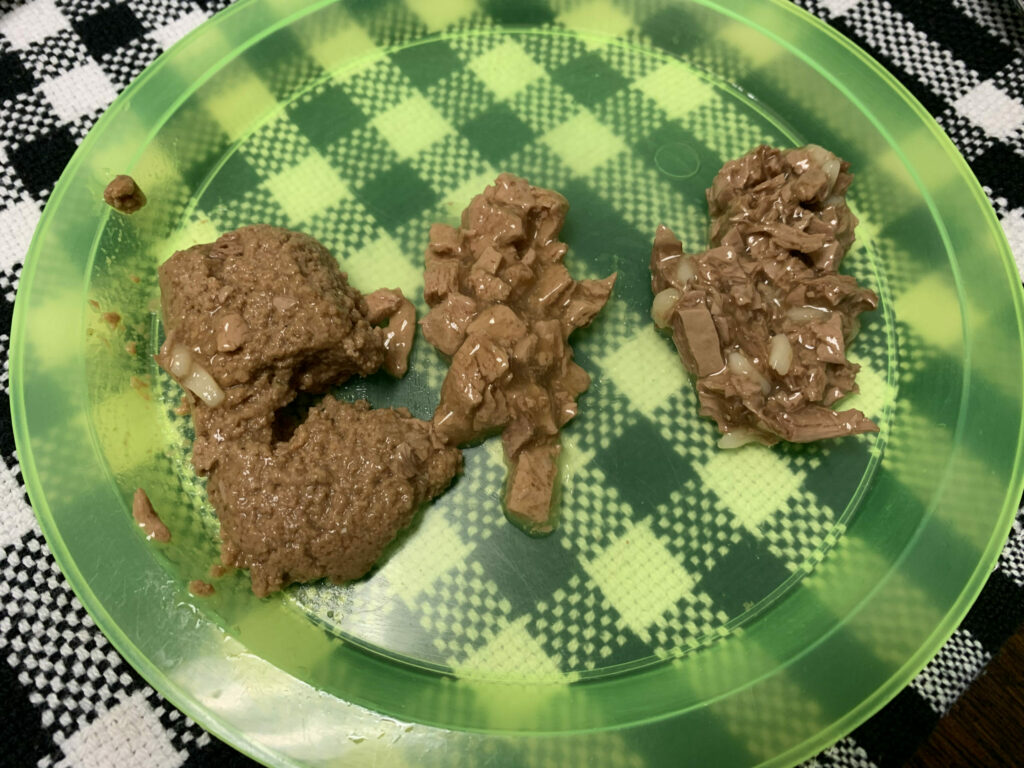
Figure 1. Introducing cats to canned food may include offering options of different textures and flavours, in order to successfully identify the cat’s particular preferences.
A diagnosis of urolithiasis has traditionally been considered a surgical problem. However, with appropriate imaging (Figure 2a) and the use of databases which can assist with predicting the stone type, an alternative approach of dietary dissolution is available whenever struvite stones are suspected. Feeding a urinary diet which promotes the dissolution of struvite uroliths can prevent unnecessary invasive and expensive surgical removal. Cats with uroliths that are started on these diets should be monitored by sequential imaging, which allows detection of changes in the size of the urolith(s) present. Following initiation of the diet, a recheck at 2 or 3 weeks is ideal. A reduction of >50% in urolith size signals that the diet is likely to be successful at stone dissolution, thus avoiding surgery (Figure 2b). These diets are subsequently helpful as preventive diets, continuing to provide ideal nutrition to an otherwise healthy adult cat, while reducing the risk of future stone formation.
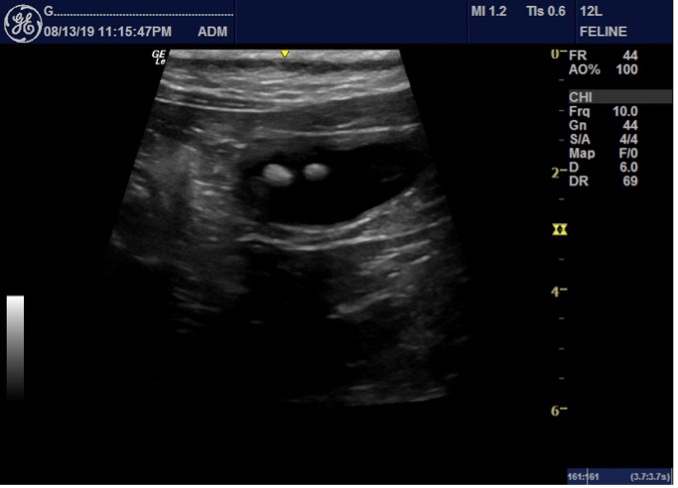
Figure 2a: Imaging is an important part of diagnostic testing for cats with FLUTD and should be monitored at intervals of 2-3 weeks for cats with uroliths that are being managed with a struvite urolith dissolution diet. A 5-year-old, female spayed Cornish Rex eating an exclusively dry, grain-free diet was presented with clinical signs of FLUTD including macroscopic hematuria. Urinalysis showed an elevated USG >1.060, an elevated urinary pH at 7.2 and hematuria. Imaging revealed 2 cystouroliths.
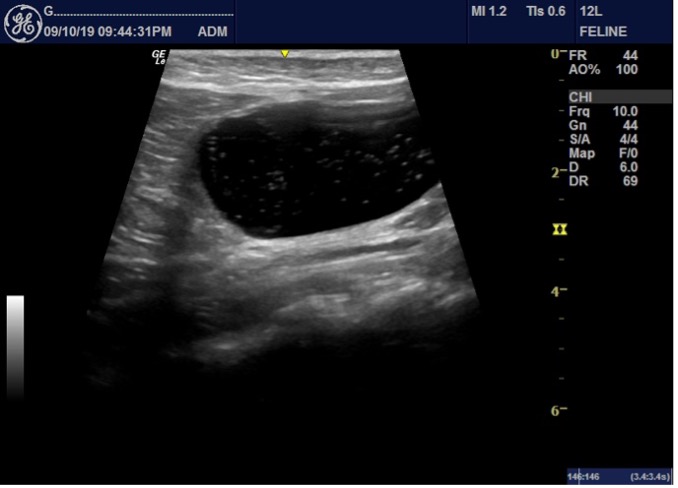
Figure 2b: The cat was transitioned to a urinary dissolution diet in dry and canned formulation. Recheck imaging several weeks later confirmed complete dissolution of the presumptive struvite urocystoliths.
Failure to show changes in urolith size signal that the stone type is unlikely to be responsive to dietary dissolution strategies, at which time other interventional options should be considered, including voiding urohydropulsion, cystoscopic basket retrieval, intracorporal lithotripsy, percutaneous cystolithotomy or surgical cystotomy.7 Certain feline urocystolith types such as calcium oxalate and ammonium urate, are unlikely to respond to dietary dissolution and likely require other interventional options as described above. Readers are referred to the ACVIM Small Animal Consensus Recommendations on the Treatment and Prevention of Uroliths in Dogs and Cats for additional information.7
Promotion of water intake and other methods to reduce urine concentration are recommended in the treatment and prevention of FLUTD.7 Water intake can be promoted by transitioning the diet to all canned food. Additional water (1 to 2 tbsp) may be added to canned food if the cat is receptive. Identification of water intake preferences is also ideal.8 Factors related to water preferences include freshness, temperature, taste, movement (water fountains, faucets), and container shape (wide bowls that reduce whisker contact stimulation may be preferred by some cats).8 Although one study did not find any difference in water consumption between still, free-falling and circulating water bowls,9 identifying individual cat preferences may still be relevant. Introduction of fountains should be slow, with the expectation that cats will initially be leery of the fountain due to its novelty. Allowing the cat to approach the fountain voluntarily and with positive reinforcement, many cats will become more comfortable with a water fountain within days to weeks. Patience is required and caregivers should be advised not to discard the idea too hastily. Water vessels should be provided in more than one location throughout the household. While definitive research is lacking, feline health experts recommend that water bowls be placed away from feeding stations as the cat’s natural preference is to keep food away from water sources.
For cats with FIC and those more susceptible to stress-related illness, nutraceutical products which assist in reduction of anxiety or alter inflammation are of potential benefit. Products which contain L-theanine, Alpha-S1 tryptic casein, milk hydrolysate alpha-casozepine, whey protein and/or omega-3 fatty acids (OFA-3) are available commercially for the feline species.10,11 However, since the process of medicating a cat may increase stress and anxiety, these products should be chosen based on the cat’s willingness to consume them. Alternatively, therapeutic urinary diets for urolith prevention and management are also available containing some of the above supplements. Added OFA-3, alpha-casozepine and/or supplemental L-tryptophan, offer the added benefits of helping to relieve stress and anxiety, potentially reducing episode flareups.10,11
There is often a lack of understanding by caregivers of the cat’s emotional needs for mental and cognitive well-being, as well as a lack of understanding of what is essential to create a healthy feline environment. As a result, indoor cats with no outdoor access often experience increased stress and anxiety due to deficiencies in their care. These needs are concisely summarized in the 5 pillars of a healthy feline environment (Figure 3). When these needs are met, cats experience better physical, mental, and cognitive well-being.12 Cats experiencing or predisposed to stress-related health conditions such as FIC benefit greatly from the reduced stress associated with meeting the 5 pillars of a healthy feline environment.13 Working with caregivers, veterinary teams should review the pillars and identify deficiencies that exist. By providing counselling on how to meet these deficiencies, an approach described as multimodal environmental modification (MEMO), cats with FIC have been demonstrated to experience a reduction in health issues related to stress.13
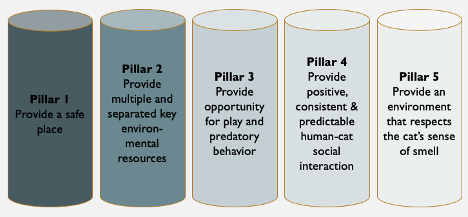
Figure 3: The Five Pillars of a Healthy Feline Environment. Adapted from AAFP and ISFM feline environmental needs guidelines. JFMS 2013: 15(3):219-230
Whatever the cause of FLUTD, management and prevention involve a multimodal, team approach. Caregiver involvement and understanding is essential to success. Providing ongoing support to the caregiver includes guidance with each change that is made. Caregivers may fear for their cat’s health and survival, may have objections to certain diets or diet formulations we recommend and may have difficulty with or reticence about medicating their cat. It is the role of the veterinary team to support the caregiver through these concerns every step of the way. The successful management of FLUTD through a team effort will improve the likelihood that the caregiver will continue with preventive care, including maintaining a close bond with the veterinary practice.
References:
1. Gerber B, Eichenberger S, Reusch CE. Guarded long-term prognosis in male cats with urethral obstruction. Journal of Feline Medicine & Surgery [Internet]. 2008;10(1):16–23. Available from: http://eutils.ncbi.nlm.nih.gov/entrez/eutils/elink.fcgi?dbfrom=pubmed&id=17719255&retmode=ref&cmd=prlinks
2. Weese JS, Blondeau J, Boothe D, Guardabassi LG, Gumley N, Papich M, et al. International Society for Companion Animal Infectious Diseases (ISCAID) guidelines for the diagnosis and management of bacterial urinary tract infections in dogs and cats. The Veterinary Journal [Internet]. 2019;247:8–25. Available from: https://linkinghub.elsevier.com/retrieve/pii/S109002331830460X
3. Defauw PAM, Maele IV de, Duchateau L, Polis IE, Saunders JH, Daminet S. Risk factors and clinical presentation of cats with feline idiopathic cystitis. Journal of Feline Medicine & Surgery [Internet]. 2011;13(12):967–75. Available from: http://eutils.ncbi.nlm.nih.gov/entrez/eutils/elink.fcgi?dbfrom=pubmed&id=22075439&retmode=ref&cmd=prlinks
4. Cooper ES. Controversies in the management of feline urethral obstruction. Journal of veterinary emergency and critical care (San Antonio, Tex : 2001) [Internet]. 2015;25(1):130–7. Available from: http://eutils.ncbi.nlm.nih.gov/entrez/eutils/elink.fcgi?dbfrom=pubmed&id=25590677&retmode=ref&cmd=prlinks
5. Jukes A, Lui M, Morton JM, MARSHALL R, Yeow N, Gunew M. Associations between increased body condition score, bodyweight, age and breed with urethral obstruction in male castrated cats. Veterinary journal (London, England : 1997) [Internet]. 2019;244:7–12. Available from: http://eutils.ncbi.nlm.nih.gov/entrez/eutils/elink.fcgi?dbfrom=pubmed&id=30825898&retmode=ref&cmd=prlinks
6. Queau Y, Bijsmans ES, Feugier A, Biourge VC. Increasing dietary sodium chloride promotes urine dilution and decreases struvite and calcium oxalate relative supersaturation in healthy dogs and cats. J Anim Physiol An N. 2020;104(5):1524–30.
7. Lulich JP, Berent AC, Adams LG, Westropp JL, Bartges JW, Osborne CA. ACVIM Small Animal Consensus Recommendations on the Treatment and Prevention of Uroliths in Dogs and Cats. Journal of Veterinary Internal Medicine [Internet]. 2016;30(5):1564–74. Available from: http://eutils.ncbi.nlm.nih.gov/entrez/eutils/elink.fcgi?dbfrom=pubmed&id=27611724&retmode=ref&cmd=prlinks
8. Westropp JL, Delgado M, Buffington CAT. Chronic Lower Urinary Tract Signs in Cats Current Understanding of Pathophysiology and Management. Vet Clin North Am Small Animal Pract. 2019;49(2):187–209.
9. Robbins MT, Cline MG, Bartges JW, Felty E, Saker KE, Bastian R, et al. Quantified water intake in laboratory cats from still, free-falling and circulating water bowls, and its effects on selected urinary parameters. J Feline Med Surg. 2019;21(8):682–90.
10. Landsberg G, Milgram B, Mougeot I, Kelly S, Rivera C de. Therapeutic effects of an alpha-casozepine and L-tryptophan supplemented diet on fear and anxiety in the cat. Journal of Feline Medicine & Surgery [Internet]. 2017;19(6):594–602. Available from: http://journals.sagepub.com/doi/10.1177/1098612X16669399
11. Kruger JM, Lulich JP, MacLeay J. Comparison of foods with differing nutritional profiles for long-term management of acute nonobstructive idiopathic cystitis in cats. Journal of the American Veterinary Medical Association [Internet]. 2015; Available from: http://avmajournals.avma.org/doi/abs/10.2460/javma.247.5.508
12. Ellis SLH, Rodan I, Carney HC, Heath S, Rochlitz I, Shearburn LD, et al. AAFP and ISFM feline environmental needs guidelines. Journal of Feline Medicine & Surgery [Internet]. 2013;15(3):219–30. Available from: http://eutils.ncbi.nlm.nih.gov/entrez/eutils/elink.fcgi?dbfrom=pubmed&id=23422366&retmode=ref&cmd=prlinks
13. Buffington CAT, Westropp JL, Chew DJ, Bolus RR. Clinical evaluation of multimodal environmental modification (MEMO) in the management of cats with idiopathic cystitis. Journal of Feline Medicine & Surgery [Internet]. 2006;8(4):261–8. Available from: http://eutils.ncbi.nlm.nih.gov/entrez/eutils/elink.fcgi?dbfrom=pubmed&id=16616567&retmode=ref&cmd=prlinks
Today’s VETgirl blog is sponsored by Royal Canin. Recommend multifunction Royal Canin Urinary SO® + Calm complete and balanced adult cat food to help support a healthy urinary tract while providing calming nutrients for cats facing stress. Learn more at my.royalcanin.com.
Only VETgirl members can leave comments. Sign In or Join VETgirl now!
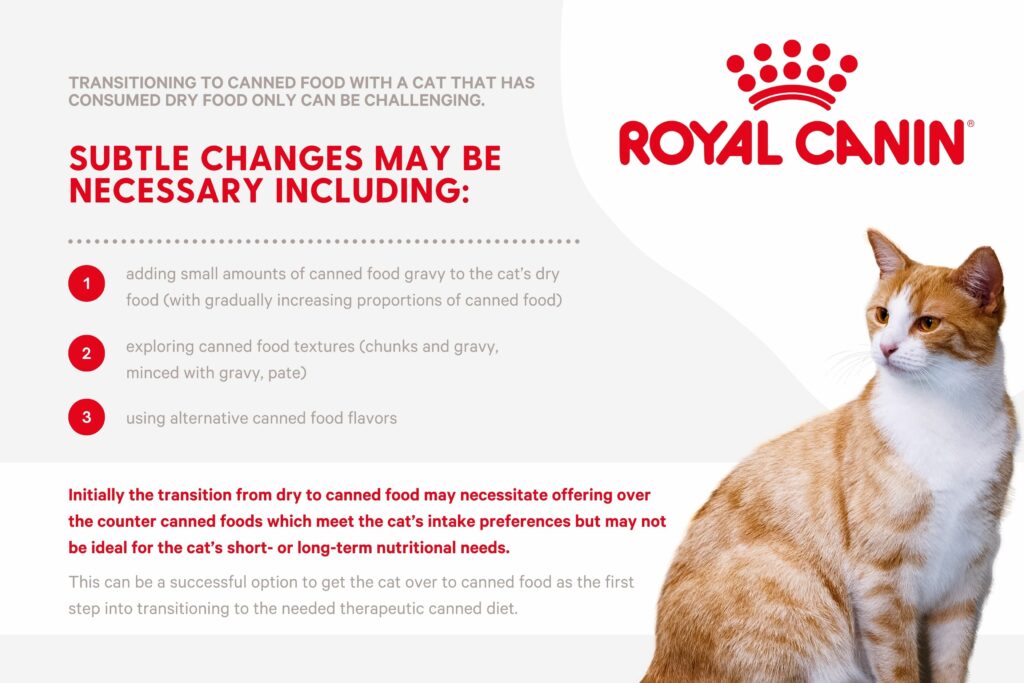
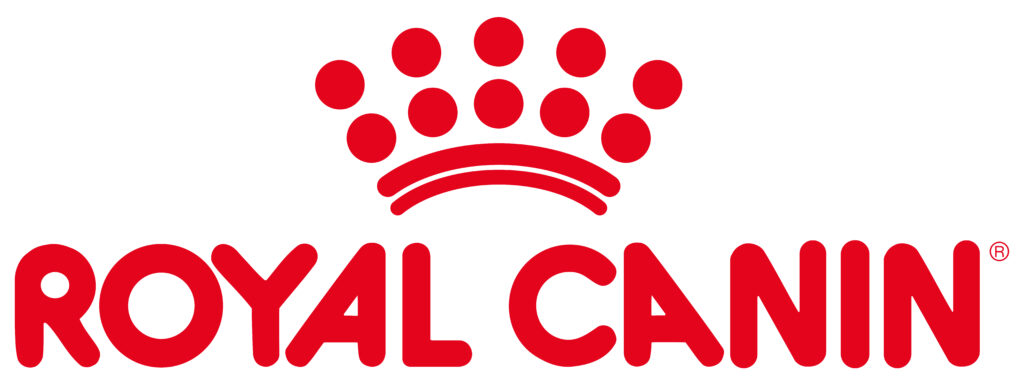
Very interested in the way lifestyle and proper ownership play a role in a cat’s health, especially in cases such as urinary issues. I enjoyed the way the author discussed dietary options used to treat FLUTD as opposed to immediately using a surgical approach. I believe this will make not only the cats happier, but also owners who can be hesitant to pursue surgery in some cases.
It’s interesting to me when owners report that they cannot think of any stressors and their cat does not appear to be stressed at home.
I have always heard about stress being the leading cause of FLUTD. Thanks for this Blog.
Thank you to the author for breaking down the common causes of FLUTD etc. and the different ways to approach treatment. It’s always nice to tell caregivers we can try a diet change instead of needing surgery. I appreciate the attention to the cat’s overall well-being as a part of treatment because it is so important. The suggestions for helping a cat switch to canned foods are very helpful.
Very informative! I have known for years about stress contributing to inappropriate elimination, but had no idea about the 5 pillars of a healthy feline environment. The tips regarding changes in diet are also very helpful.
The tips to transition from dry to canned food is very helpful